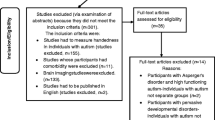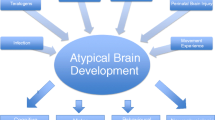Abstract
This paper is concerned with what abnormal handedness in Pervasive Developmental Disorders (PDD) reveals about the presence, lateralization, and severity of cerebral dysfunction in this population. From previous work, it was predicted that left-handedness would be elevated in the sample and that mixed-handedness subjects should be more impaired than those with established hand dominance. A battery of cognitive and motor tests were administered to a group of PDD children with autistic symptoms, and performance was compared for the left-handed, right-handed, and mixedpreference children. It was found that left-handers tended to do better than right-handers on all cognitive measures, while the mixed-preference children tended to be the lowest on all cognitive measures. No differences were found on motor measures. An extension of the Satz (1972) model, assuming early brain damage, was developed to explain the superiority of the left-handed children; an alternative explanation assuming anomalous lateralization patterns in the natural left-handers was also suggested.
Similar content being viewed by others
References
American Psychiatric Association. (1980).Diagnostic and statistical manual of mental disorders (3rd ed.). Washington, D.C.
Annet, M. (1970). The growth of manual preference and speed.British Journal of Psychology, 61, 545–588.
Bemporad, B., & Kinsbourne, M. (1983). Sinistrality and dyslexia: A possible relationship between subtypes. In M. Kinsbourne, (Ed.),Topics in learning and learning disabilities (Vol. 3). Hillsdale, New Jersey: Erlbaum.
Boucher, J. (1977). Hand preference in autistic children and their parents.Journal of Autism and Childhood Schizophrenia, 7, 177–187.
Bradshaw-McAnulty, Hicks, R., & Kinsbourne, M. (1984). Pathological left handedness and familial sinistrality in relation to degree of mental retardation.Brain and Cognition, 3, 349–356.
DeMyer, M., Churchill, D., Pontius, W., & Gilkey, K. (1971). A comparison of five diagnostic systems for childhood schizophrenia and infantile autism.Journal of Autism and Childhood Schizophrenia, 1, 175–189.
Denckla, M. B. (1973). Development of speed in repetitive and successive finger movements in normal children.Developmental Medicine and Child Neurology, 15, 635–645.
Denckla, M. B. (1974). Development of motor co-ordination in normal children.Developmental Medicine and Child Neurology, 16, 729–741.
Dunn, L. (1965).Peabody Picture Vocabulary Test. Circle Pines, Minnesota: American Guidance Service.
Fein, D., Humes, M., Kaplan, E., Lucci, D., & Waterhouse, L. (1984). The question of left hemisphere dysfunction in infantile autism.Psychological Bulletin, 95, 258–281.
Fein, D., Waterhouse, L., Lucci, D., & Snyder, D. (1985). Cognitive subtypes in developmentally disabled children: A pilot study.Journal of Autism and Developmental Disorders, 15, 77–95.
Geschwind, N., & Behan, P. (1982). Left-handedness: Association with immune disease, migraine, and developmental learning disorder.Proceedings of the National Academy of Science, 79, 5097–5100.
Hardyck, C., & Petrinovich, L. F. (1977). Left-handedness.Psychological Bulletin, 84, 385–404.
Hauser, S. L., DeLong, G. R., & Rosman, N. P. (1975). Pneumographic findings in the infantile autism syndrome.Brain, 98, 667–688.
Hecaen, H., & Ajuriaguerra, J. (1964).Left-handedness. New York: Grune and Stratton.
Kanner, L. (1943). Autistic disturbance of affective contact.Nervous Child, 2, 217–250.
Kinsbourne, M. (1975). Cerebral dominance, learning, and cognition. In H. Myklebust (Ed.),Progress in learning disabilities (Vol. 3). New York: Grune and Stratton.
Levy, J. (1974). Psychobiological measures of bilateral asymmetry. In S. J. Diamond (Ed.),Hemispheric functions in the human brain. New York: Wiley Press.
Masure, M. D., & Benton, A. L. (1983). Visuospatial performance in left-handed patients with unilateral brain lesions.Neuropsychologia, 21, 119–188.
McCarthy, D. (1972).McCarthy Scales of Children's Abilities. New York: Psychological Corp.
Miller, E. (1971). Handedness and the pattern of human ability.British Journal of Psychology, 62, 111–112.
Milner, B., Branch, C., & Rasmussen, T. (1964). Observations on cerebral dominance. In A. V. S. de Reuck & M. O'Connor (Eds.),Ciba Foundation symposium on disorders of language. London: J. and A. Churchill.
Newsom, C., & Rincover, A. (1979). Behavioral assessment of autistic children. In E. J. Mash & L. G. Terdal, (Eds.),Behavioral assessment of childhood disorders. New York: Guilford Press.
Prior, M., Boulton, D., Gajzago, C., & Perry, D. (1975). The classification of childhood psychoses by numerical taxonomy.Journal of Child Psychology and Psychiatry, 16, 321–330.
Prior, M., & Bradshaw, J. (1979). Hemisphere functioning in autistic children.Cortex, 15, 73–81.
Rimland, B. (1971). The differentiation of infantile autism from other forms of childhood psychosis.Journal of Autism and Childhood Schizophrenia, 1, 161–174.
Rutter, M. (1977). Infantile autism and other childhood psychoses. In M. Rutter & L. Herbov (Eds.),Child psychiatry: Modern approach. Oxford: Blackwell.
Satz, P. (1972). Pathological left-handedness: An explanatory model.Cortex, 8, 121–135.
Satz, P. (1973). Left-handedness and early brain insult: An explanation.Neuropsychologia, 11, 115–117.
Segalowitz, S. J., & Bryden, M. P. (1983). Individual differences in hemispheric representation of language. In S. J. Segalowitz (Ed.),Language functions and brain organization. New York: Academic Press.
Silva, D., & Satz, P. (1979). Pathological left handedness: Evaluation of a model.Brain and Language, 7, 8–16.
Soper, H. V., Satz, P., Orsini, D. L., McCallum, S., & Henry, R. (1984).Model for ambiguous handedness in autism. Paper presented at the meeting of the International Neuropsychological Society, Houston.
Tsai, L. Y. (1982). Handedness in autistic children and their families.Journal of Autism and Developmental Disorders, 12, 421–423.
Tsai, L. Y. (1983). The relationship of handedness to the cognitive, language and visuo-spatial skills of autistic patients.British Journal of Psychiatry, 142, 156–162.
Waterhouse, L., Fein, D., Nath, J., & Snyder, D. (in press). Pervasive developmental disorders and schizophrenia occurring in childhood: A review of critical commentary. In G. Tischler (Ed.),DSM-III: An interim appraisal. Washington, D.C.: APA.
Author information
Authors and Affiliations
Additional information
This research was supported by a project grant from NIMH (28605) to Drs. Waterhouse and Fein, and by Research Scientist Development Awards to Drs. Fein and Pennington. We would like to extend special thanks to Dr. Marcel Kinsbourne and to Dr. Robin Morris for important theoretical contributions to the work. We are very grateful to the staff and students of the League School (Newton, Massachusetts), the Eden Institute (Princeton, New Jersey), the Mercer Country Community Guidance Center Day School (Trenton, New Jersey), the Midland School (Somerville, New Jersey), and Search Day Program (Ocean, New Jersey). We wish to thank Chris Brumbach, Laurie Miller, Helen Garretson, Karin Kerensky, and Joane Jenkins for their patience and skill in testing the children.
Rights and permissions
About this article
Cite this article
Fein, D., Waterhouse, L., Lucci, D. et al. Handedness and cognitive functions in Pervasive Developmental disorders. J Autism Dev Disord 15, 323–333 (1985). https://doi.org/10.1007/BF01531502
Issue Date:
DOI: https://doi.org/10.1007/BF01531502




